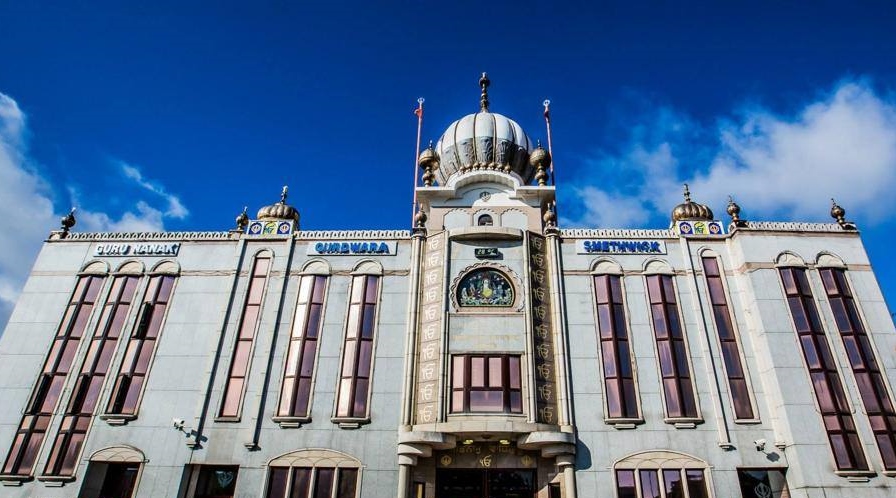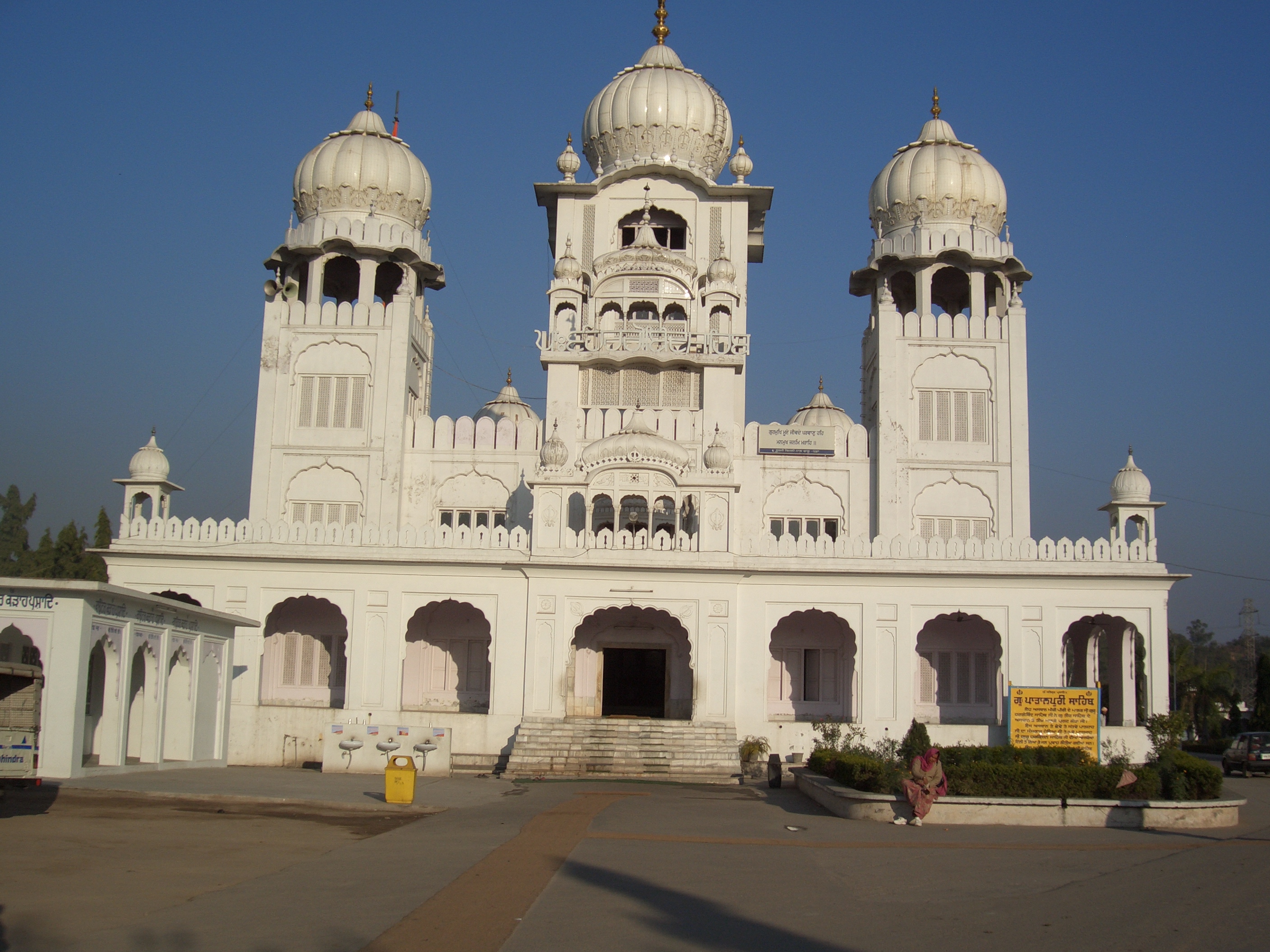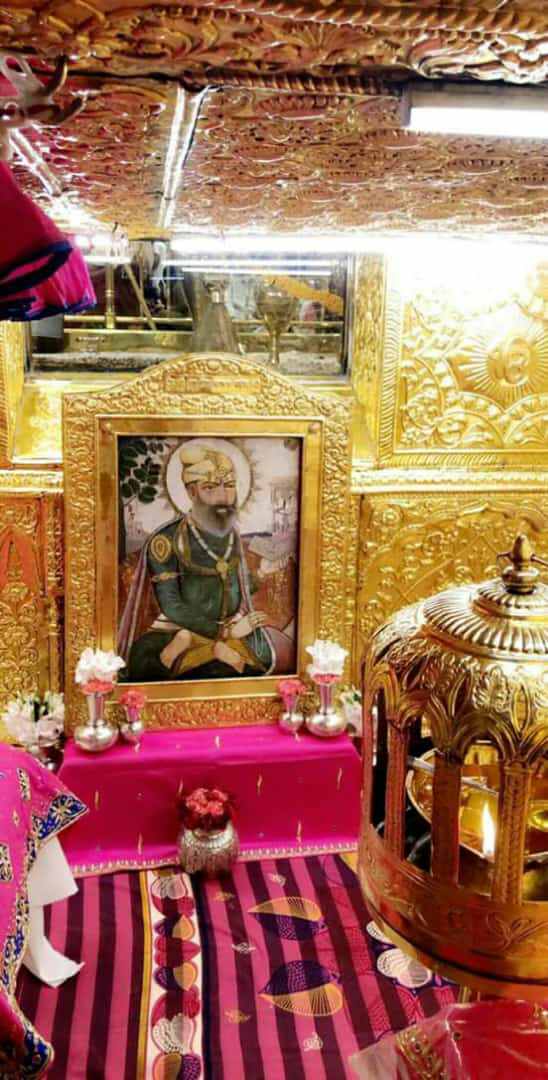|
Kiratpur Sahib
Kiratpur also known as Kiratpur Sahib is a town in Rupnagar district, Punjab, India. The town is the location of the Gurdwara Patal Puri where many Sikhs take ashes of their deceased. Kiratpur Sahib Town Kiratpur Sahib (31.1820758°n 76.5635490°e) was established in 1627 by the 6th Sikh Guru, Guru Hargobind, who bought the land from Raja Tara Chand of Kehlur through his son, Baba Gurditta. The place is also associated with the memory of a Muslim saint, Pir Buddan Shah. It is situated on the bank of the Sutlej about 10 km south of Anandpur, about 30 km north of Rupnagar and 90 km from Chandigarh on the Nangal-Rupnagar-Chandigarh road (NH21). It is a sacred place for the Sikhs. Guru Nanak Dev is said to have visited this place when it was little more than a wilderness. Guru Hargobind, the sixth Guru spent the last few years of his life here. Both Guru Har Rai and Guru Harkrishan were also born at this place and they received the Gurgadi (Guruship) at this pl ... [...More Info...] [...Related Items...] OR: [Wikipedia] [Google] [Baidu] |
States And Territories Of India
India is a federal union comprising 28 states and 8 union territories, with a total of 36 entities. The states and union territories are further subdivided into districts and smaller administrative divisions. History Pre-independence The Indian subcontinent has been ruled by many different ethnic groups throughout its history, each instituting their own policies of administrative division in the region. The British Raj mostly retained the administrative structure of the preceding Mughal Empire. India was divided into provinces (also called Presidencies), directly governed by the British, and princely states, which were nominally controlled by a local prince or raja loyal to the British Empire, which held ''de facto'' sovereignty ( suzerainty) over the princely states. 1947–1950 Between 1947 and 1950 the territories of the princely states were politically integrated into the Indian union. Most were merged into existing provinces; others were organised into ... [...More Info...] [...Related Items...] OR: [Wikipedia] [Google] [Baidu] |
Veer-Zaara
''Veer-Zaara'' () is a 2004 Indian Hindi-language romantic drama film directed by Yash Chopra, who co-produced it with his son Aditya Chopra. It stars Shah Rukh Khan and Preity Zinta as the eponymous star-crossed lovers: Veer Pratap Singh (Khan) is an Indian Air Force officer, and Zaara Hayaat Khan (Zinta) is the daughter of a Pakistani politician. Veer is imprisoned on false charges, and a young Pakistani lawyer, named Saamiya Siddiqui (Rani Mukerji), fights his case. Amitabh Bachchan, Hema Malini, Divya Dutta, Manoj Bajpayee, Boman Irani, Anupam Kher and Kirron Kher play supporting roles. Chopra wanted to make his return to cinema after 7 years; he was dissatisfied with the scripts he received. Aditya then narrated a few scenes of a story he had written, which interested Chopra and prompted him to direct it. Chopra intended the film to be a tribute to Punjab; it was to be titled ''Yeh Kahaan Aa Gaye Hum,'' based on an eponymous song from Yash Chopra's ''Silsila'' (1981). Se ... [...More Info...] [...Related Items...] OR: [Wikipedia] [Google] [Baidu] |
Gurudawara Charankamal Sahib
A gurdwara (sometimes written as gurudwara) (Gurmukhi: ਗੁਰਦੁਆਰਾ ''guradu'ārā'', meaning "Door to the Guru") is a place of assembly and worship for Sikhs. Sikhs also refer to gurdwaras as ''Gurdwara Sahib''. People from all faiths are welcomed in gurdwaras. Each gurdwara has a '' Darbar Sahib'' where the current and everlasting guru of the Sikhs, the scripture Guru Granth Sahib, is placed on a (an elevated throne) in a prominent central position. Any congregant (sometimes with specialized training, in which case they can be known by the term granthi) may recite, sing, and explain the verses from the Guru Granth Sahib, in the presence of the rest of the congregation. All gurdwaras have a hall, where people can eat free vegetarian food served by volunteers at the gurdwara. They may also have a medical facility room, library, nursery, classroom, meeting rooms, playground, sports ground, a gift shop, and finally a repair shop. A gurdwara can be identified from a dist ... [...More Info...] [...Related Items...] OR: [Wikipedia] [Google] [Baidu] |
Gurudawara Manji Sahib
A gurdwara (sometimes written as gurudwara) (Gurmukhi: ਗੁਰਦੁਆਰਾ ''guradu'ārā'', meaning "Door to the Guru") is a place of assembly and worship for Sikhs. Sikhs also refer to gurdwaras as ''Gurdwara Sahib''. People from all faiths are welcomed in gurdwaras. Each gurdwara has a '' Darbar Sahib'' where the current and everlasting guru of the Sikhs, the scripture Guru Granth Sahib, is placed on a (an elevated throne) in a prominent central position. Any congregant (sometimes with specialized training, in which case they can be known by the term granthi) may recite, sing, and explain the verses from the Guru Granth Sahib, in the presence of the rest of the congregation. All gurdwaras have a hall, where people can eat free vegetarian food served by volunteers at the gurdwara. They may also have a medical facility room, library, nursery, classroom, meeting rooms, playground, sports ground, a gift shop, and finally a repair shop. A gurdwara can be identified from a dist ... [...More Info...] [...Related Items...] OR: [Wikipedia] [Google] [Baidu] |
Gurudawara Shish Mahal Sahib, Kiratpur Sahib
A gurdwara (sometimes written as gurudwara) (Gurmukhi: ਗੁਰਦੁਆਰਾ ''guradu'ārā'', meaning "Door to the Guru") is a place of assembly and worship for Sikhs. Sikhs also refer to gurdwaras as ''Gurdwara Sahib''. People from all faiths are welcomed in gurdwaras. Each gurdwara has a '' Darbar Sahib'' where the current and everlasting guru of the Sikhs, the scripture Guru Granth Sahib, is placed on a (an elevated throne) in a prominent central position. Any congregant (sometimes with specialized training, in which case they can be known by the term granthi) may recite, sing, and explain the verses from the Guru Granth Sahib, in the presence of the rest of the congregation. All gurdwaras have a hall, where people can eat free vegetarian food served by volunteers at the gurdwara. They may also have a medical facility room, library, nursery, classroom, meeting rooms, playground, sports ground, a gift shop, and finally a repair shop. A gurdwara can be identified from a dist ... [...More Info...] [...Related Items...] OR: [Wikipedia] [Google] [Baidu] |
Gurudwara Babangarh Sahib, Kiratpur Sahib
A gurdwara (sometimes written as gurudwara) (Gurmukhi: ਗੁਰਦੁਆਰਾ ''guradu'ārā'', meaning "Door to the Sikh gurus, Guru") is a place of assembly and place of worship, worship for Sikhs. Sikhs also refer to gurdwaras as ''Gurdwara Sahib''. People from all faiths are welcomed in gurdwaras. Each gurdwara has a ''Darbar Sahib Hall, Darbar Sahib'' where the current and everlasting guru of the Sikhs, the scripture Guru Granth Sahib, is placed on a (an elevated throne) in a prominent central position. Any congregant (sometimes with specialized training, in which case they can be known by the term granthi) may recite, sing, and explain the verses from the Guru Granth Sahib, in the presence of the rest of the congregation. All gurdwaras have a hall, where people can eat free vegetarian food served by volunteers at the gurdwara. They may also have a medical facility room, library, nursery, classroom, meeting rooms, playground, sports ground, a gift shop, and finally a repair ... [...More Info...] [...Related Items...] OR: [Wikipedia] [Google] [Baidu] |
Gurudwara Baba Gurditta Ji, Kiratpur Sahib
Gurudwara Baba Gurditta Ji is a Sikh temple (''gurdwara'') in the village of Chandpur Rurki of Nawanshahr District in Indian Punjab. The gurudwara is situated at the entrance of the village and about 1.5 km from Garhshankar-Anandpur Sahib link highway. It was built in memory of Baba Gurditta and Baba Kesra Singh Ji. Famous visitors Gurudwara Baba Gurditta Ji is a historical and holy place for Sikhism. Baba Gurditta Ji visited Chandpur Rurki with two associates. They stayed one night along with their horse. This Gurudwara has two Samadhis for two associates, held in main Gurudwara Sahib Ji. Herein Baba Ji traveled on horseback along with two associates, and took rest here. The chain with which they tied their horse is still visible in Gurudwara Sahib. Events and celebrations All events, functions and ceremonies that take place at the Gurudwara have always been started with remembrances to Baba Gurditta Ji. A phrase frequently used there is "Dhan-Dhan Baba Gurditta ji, De ... [...More Info...] [...Related Items...] OR: [Wikipedia] [Google] [Baidu] |
Kiratpur Sahib
Kiratpur also known as Kiratpur Sahib is a town in Rupnagar district, Punjab, India. The town is the location of the Gurdwara Patal Puri where many Sikhs take ashes of their deceased. Kiratpur Sahib Town Kiratpur Sahib (31.1820758°n 76.5635490°e) was established in 1627 by the 6th Sikh Guru, Guru Hargobind, who bought the land from Raja Tara Chand of Kehlur through his son, Baba Gurditta. The place is also associated with the memory of a Muslim saint, Pir Buddan Shah. It is situated on the bank of the Sutlej about 10 km south of Anandpur, about 30 km north of Rupnagar and 90 km from Chandigarh on the Nangal-Rupnagar-Chandigarh road (NH21). It is a sacred place for the Sikhs. Guru Nanak Dev is said to have visited this place when it was little more than a wilderness. Guru Hargobind, the sixth Guru spent the last few years of his life here. Both Guru Har Rai and Guru Harkrishan were also born at this place and they received the Gurgadi (Guruship) at this pl ... [...More Info...] [...Related Items...] OR: [Wikipedia] [Google] [Baidu] |
Rattan Chand
Rattan Chand is an Indian former senior bureaucrat who has served Government of India at various positions for more than 35 years. Apart from working at senior positions in Government of India he has also been a resource person to USAID, World Bank, International Monetary Fund (IMF), United Nations, World Health Organization, Ministry of Health and Family Welfare Government of India and many other organisations. He has represented Government of India at many International Meetings, Conferences, Working Sessions, Seminars worldwide mainly in the Health Sector. He is a National Monitor, National Health Mission and member of working group of National Statistical Commission, Government of India and senior expert for World Bank. Career Chand has reorganised the ‘Bulletin on Rural Health Statistics’ and updated it regularly. As a senior official in National Sample Survey Organisation, he handled important work of survey of unorganised sector enterprises and drafted the first ev ... [...More Info...] [...Related Items...] OR: [Wikipedia] [Google] [Baidu] |
Bhai Jiwan Singh
Baba Jiwan Singh (Gurmukhi: ਬਾਬਾ ਜੀਵਨ ਸਿੰਘ; 13 December 1661 – 22 December 1704), born Jaitha, was a Sikh general and companion of Guru Gobind Singh. Early life Bhai Jaita was born in 1661 at Patna, Bihar (India) to Sada Nand and mother, Mata Premo transcendence and immanence, in pantheism and nondualism. He grew up at Patna where he got training in various weapons and learned the art of warfare. In addition, he learned horse-riding, swimming, music, and Kirtan. When Sikh families staying at Patna returned to Punjab Bhai Jaita and his family went to Ramdas village and lived with Bhai Gurditta, the great-grandson of Baba Buddha. Later, Jaita married Bibi Raj Kaur, daughter of Surjan Singh. When Guru Tegh Bahadur, the ninth guru of Sikh, was martyred by the Mughals at Chandni Chowk, Delhi, Bhai Jiwan Singh along with two other Sikhs, recovered his dismembered body from a Muslim crowd and brought it back to his son, Guru Gobind Singh. There after Gu ... [...More Info...] [...Related Items...] OR: [Wikipedia] [Google] [Baidu] |
Guru Tegh Bahadur
Guru Tegh Bahadur ( Punjabi: ਗੁਰੂ ਤੇਗ਼ ਬਹਾਦਰ (Gurmukhi); ; 1 April 1621 – 11 November 1675) was the ninth of ten Gurus who founded the Sikh religion and the leader of Sikhs from 1665 until his beheading in 1675. He was born in Amritsar, Punjab, India in 1621 and was the youngest son of Guru Hargobind, the sixth Sikh guru. Considered a principled and fearless warrior, he was a learned spiritual scholar and a poet whose 115 hymns are included in ''Sri Guru Granth Sahib,'' the main text of Sikhism. Guru Tegh Bahadur was executed on the orders of Aurangzeb, the sixth Mughal emperor, in Delhi, India.;;; Sikh holy premises Gurudwara Sis Ganj Sahib and Gurdwara Rakab Ganj Sahib in Delhi mark the places of execution and cremation of Guru Tegh Bahadur. His martyrdom is remembered as the ''Shaheedi Divas of Guru Tegh Bahadur'' every year on 24 November. Biography Early life Guru Tegh Bahadur was the youngest son of Guru Hargobind, the sixth guru: Guru ... [...More Info...] [...Related Items...] OR: [Wikipedia] [Google] [Baidu] |
Guru Gobind Singh
Guru Gobind Singh (; 22 December 1666 – 7 October 1708), born Gobind Das or Gobind Rai the tenth Sikh Guru, a spiritual master, warrior, poet and philosopher. When his father, Guru Tegh Bahadur, was executed by Aurangzeb, Guru Gobind Singh was formally installed as the leader of the Sikhs at the age of nine, becoming the tenth and final human Sikh Guru. His four biological sons died during his lifetime – two in battle, two executed by the Mughal governor Wazir Khan.; Among his notable contributions to Sikhism are founding the '' Sikh'' warrior community called ''Khalsa'' in 1699 and introducing ''the Five Ks'', the five articles of faith that Khalsa Sikhs wear at all times. Guru Gobind Singh is credited with the ''Dasam Granth'' whose hymns are a sacred part of Sikh prayers and Khalsa rituals. He is also credited as the one who finalized and enshrined the ''Guru Granth Sahib'' as Sikhism's primary scripture and eternal Guru. Family and early life Gobind Singh was t ... [...More Info...] [...Related Items...] OR: [Wikipedia] [Google] [Baidu] |









